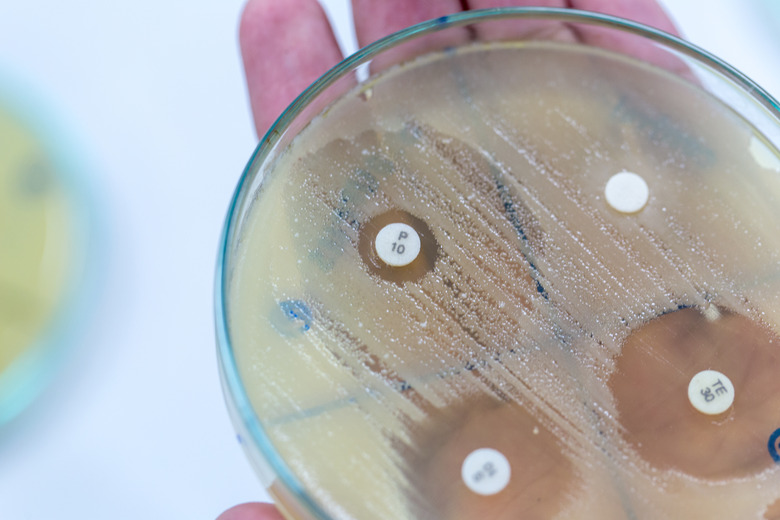How Does Alcohol Kill Bacteria?
Alcohol has been used as a disinfectant for centuries. The most common sterilizing products used today – rubbing alcohol and alcohol-based hand sanitizers – are both made from solutions of alcohol, most often isopropyl or ethyl alcohol. In Ancient Egypt, circa 3000 B.C,, palm wine was used both to clean wounds and embalm bodies. Alcohol is incredibly effective in the fight against single-celled microorganisms like bacteria, but commercials and other advertisements for household disinfectants don't often explain the fascinating process of how alcohol kills bacteria.
TL;DR (Too Long; Didn't Read)
Alcohol kills bacteria through a process known as denaturation. Alcohol molecules are amphiphile chemical compounds, which means that they have both water and fat-loving properties. Because bacterial cell membranes have a fat-based side as well as a water-based side, alcohol molecules are able to bond with and break down the protective membrane. When this occurs, the core components of the bacteria are exposed and dissolve, losing their structure and ceasing to function. With its organs essentially melting away, the bacteria dies quickly.
Properties of Alcohol
Properties
of Alcohol
The rubbing alcohol and alcohol-based hand sanitizers most often used to kill bacteria are solutions of alcohol, either ethyl alcohol or isopropyl alcohol, both of which are amphiphile chemical compounds. This property allows them to bond with and break down water-based membranes and disrupt protein structures suspended in water. The molecules in the membranes and proteins easily bond with the alcohol molecules. Because single-celled microorganisms like bacteria and viruses are primarily composed of water, with fatty proteins suspended within them, alcohol's amphiphile characteristics make it incredibly effective as a sanitizing agent. Cells exposed to it cannot survive in alcohol's presence for more than a few minutes.
Bacterial Structure
Bacterial
Structure
The proteins that make up a bacteria are composed of chains of 20 or more fatty amino acids linked together, curled and formed into a unique shape. These shapes are rigid and are required for the proteins to properly function. Suspended in a water-based cytoplasm and surrounded by a membrane composed of fats and water molecules, these various proteins act as the workhorses of the bacterial cell. They control the swimming movement that allows the bacteria to move, they allow for cell reproduction, and prevent the bacteria from being eaten by white blood cells in the human body. Without these proteins, the bacteria would die quickly.
Death by Denaturing
Death
by Denaturing
When a bacterial cell is exposed to a solution of alcohol, the amphiphile alcohol molecules bond with the molecules of the bacteria's cell membrane, making it more soluble in water. This causes the cell membrane to lose its structural integrity and fall apart. As it grows weaker, more alcohol molecules are able to enter the cell, and the proteins suspended within the membrane begin to pour out of the weakened membrane. The alcohol molecules then begin to dissolve the proteins through a process known as denaturation. By forming bonds with the alcohol molecules, the amino acids in a given bacterial protein begin to lose their structure, ceasing to function as a result. Because the bacteria cannot survive without those protein functions, the cell dies quickly, essentially being melted apart from the inside and out.
Cite This Article
MLA
Flournoy, Blake. "How Does Alcohol Kill Bacteria?" sciencing.com, https://www.sciencing.com/alcohol-kill-bacteria-5462404/. 25 April 2018.
APA
Flournoy, Blake. (2018, April 25). How Does Alcohol Kill Bacteria?. sciencing.com. Retrieved from https://www.sciencing.com/alcohol-kill-bacteria-5462404/
Chicago
Flournoy, Blake. How Does Alcohol Kill Bacteria? last modified March 24, 2022. https://www.sciencing.com/alcohol-kill-bacteria-5462404/
